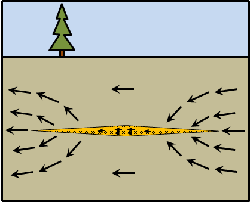 |
| A more-permeable fracture will distort local flow, thereby capturing and treating contaminated grounwater. |
|
Passive In Situ Transport of Contaminants to Stationary Treatment Media
When significant contrast exists between the hydraulic conductivity of the formation and the proppant material used to create and fill the hydraulic fracture, local fluid flow will be diverted into the treatment lens. Essentially the fracture acts a preferential flow path, and the size of the “capture zone” can well be significant. If the path is sufficiently long (fracture big enough) and / or the flow rate sufficiently slow, the residence time will be adequate for complete degradation of the contaminant. Most notably, fractures oriented parallel with local in situ flux can function as captors.
This process occurs readily when granular zero valent iron (ZVI) is used as the proppant. Case studies have demonstrated the efficacy of the approach, while modeling and theoretical considerations explain the underlying physics.
|
|